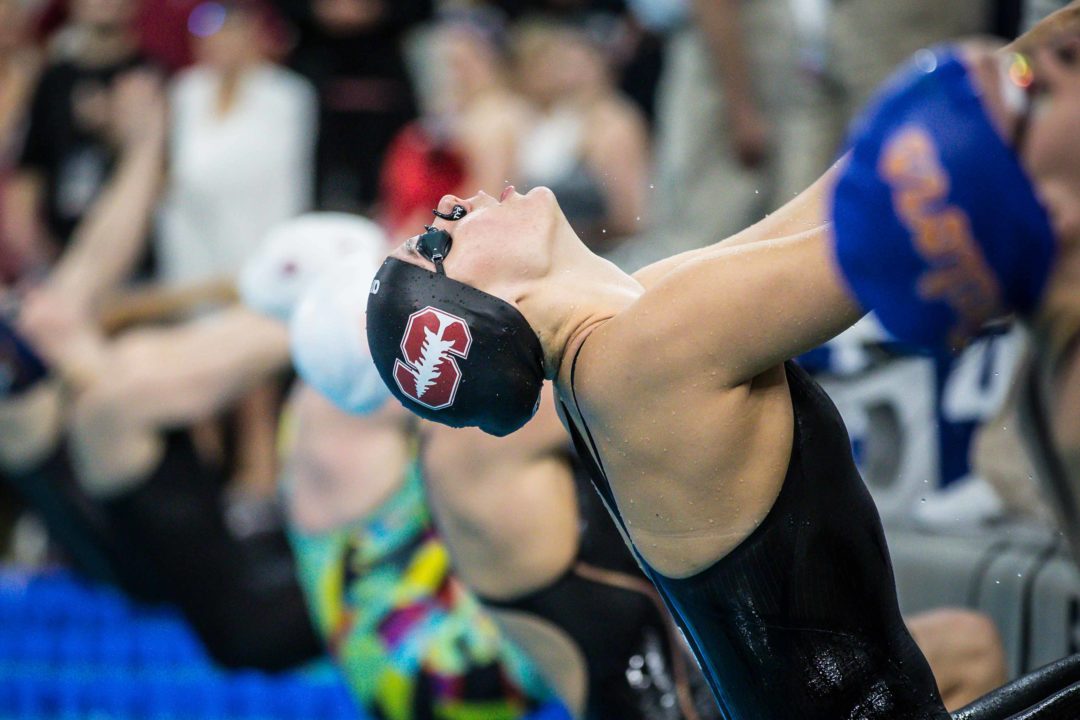Disclaimer: Dolfin Swim of the Week is not meant to be a conclusive selection of the best overall swim of the week, but rather one Featured Swim to be explored in deeper detail. The Dolfin Swim is an opportunity to take a closer look at the context of one of the many fast swims this week, perhaps a swim that slipped through the cracks as others grabbed the headlines, or a race we didn’t get to examine as closely in the flood of weekly meets.
During the busy NCAA season, we have a tradition with our Swim of the Week: using it to pick out ‘the swim that won the meet’.
Because the standout, record-breaking swims get so much coverage and attention already, we turn our focus to the team points race, and the event that ultimately flipped the meet. While Stanford’s victory wasn’t exactly a nail-biter, it was also much closer than last year. In fact, the Cardinal faced a 28.5-point deficit heading into the final day of competition.
Now, that’s not as grim as it sounds. We had long predicted Stanford to make a big run on the final day, with many of their best events lined up, and a ton of projected scoring depth. But paper points don’t get you anywhere at the NCAA level. Stanford still had to show up on Saturday morning.
That’s why the 200 back was so important. Beginning the final prelims session, Stanford needed a tone-setter. It’s often difficult to maintain energy on the fourth day of an intense, grueling competition. But Stanford’s 200 backstrokers showed up big in prelims. Coming in seeded 2nd, 5th and 8th, Stanford’s women qualified 2nd (Taylor Ruck), 4th (Lucie Nordmann) and 6th (Erin Voss). Both Nordmann and Voss dropped from seed in that prelims swim, and Ruck would drop time in the final.
With Cal only qualifying one athlete (16th out of prelims), Stanford assured themselves of gaining at least 25 points on Cal in finals of the 200 back. (Finishing 6th-7th-8th would yield 36 points to Stanford, while Cal could only get as much as 9 for winning the B final). Ultimately, in that finals swim, Stanford scored 46 to Cal’s 3, taking the meet lead for the final time.
Maybe most impressive is that this meet-turning event was carried out by two freshmen and a sophomore – Stanford relied heavily on its youngest swimmers in its third-consecutive title run. And with established stars like Ella Eastin and Katie Drabot actually falling short of their projected point totals, it was the young depth like Ruck, Nordmann and Voss who carried the day.
About Dolfin Swimwear
Dolfin Swimwear represents quality and value. We are committed to supplying our customers with a durable swim suit and an affordable price. We also will continue to be the innovaters for fun and unique practice/training suits which gives swimmers something to smile about…even during grueling workouts.
About Dolfin’s Tech Suit LightStrike
LightStrikeTM was developed after years of research in biomechanics, active drag analysis, fabric innovation, and compression analysis. This new FINA approved suit is supported by Dr. Genadijus Sokolovas, PhD in Biomechanics and former Performance Director with USA Swimming and Styku® 3D Biomapping Engineering.
 Visit Dolfin to learn more.
Visit Dolfin to learn more.
Instagram @DolfinSwimwear
Twitter: @DolfinSwim
Facebook: DolfinSwimwear
Dolfin is a SwimSwam partner.



I understand Baker’s decision to go pro (probably best for her), but she could have made the difference in the team title race.
Yes she could have, but playing that game Manuel also had a year of eligibility left
And Ledecky had 2.
And you’ve got to wonder how many of that fine rookie class signed for Stanford thinking they were joining a team where they’d get to compete with Simone Manuel & Katie Ledecky. Burn!
Possibly, but they also probably only had money for the fine rookie class because Simone and Katie were no longer on scholarships (I don’t know how much of a scholarship they were each on, but both were worthy of full rides). The freshmen probably still very much felt like they were on a team with Ledecky and Manuel, given that the two were both counting for the mile at NCAAs.
Lots of moving parts when you start playing ‘what if’ games.
Maybe… and yet Greg Meehan suggested in an interview– the video was on your site– just after NC’s that he and his assistants spent way more time teaching this last season then he’s had to do in a long time. He’d been talking up Eastin’s leadership in the interview and lauding the work she did helping the underclassmen to prepare for the coming championships, so by inference it seemed he was saying that he had to teach more because he didn’t have the seniors like Ledecky and Manuel handy to help handle the load. Makes me wonder just how involved the professionals training at Stanford were with the frosh??
Day 2 was the day Stanford won the National Championship. Despite the fact most everyone had expected Cal to end the day atop the standings with a probable cushion of 20-30 points, it was the Cardinal who wound up topping the day by a mere half point. And the key to Stanford’s surprising ascension were the 41.5 points garnered in an ownership of the 500 Free that was capped by Brooke Forde’s huge victory.
It’s hard to imagine that a big win in a relay to open the competition can require a bounce back, but nevertheless that’s how Forde’s 500 Free swim was viewed. The night before, Stanford pretty much had the 800 Free relay done and dusted thanks to… Read more »
I would also argue that Allie Raab dropping over a second from her prelims swim in the 200 breast to go from 15th to WINNING the B final set the tone for Stanford for the rest of the night. Though it didn’t win the meet for Stanford points-wise, that race was a game changer. Another impressive contribution from a freshman! Congratulations to Allie on a gutsy swim, Stanford on their championship, and Cal for putting up a great fight 🙂
Agree with you completely. It wasn’t the leading swimmers but “B” finalists who stepped up and performed much better than expected making small margin over Cal possible.